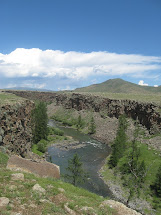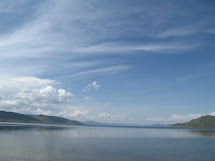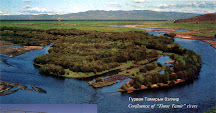
Swung by Tsetserleg, capital of Arkhangai Aimag, to visit Zayain Khuree, the monastery of Khalkh Zaya Pandita, one of Zanabazar‘s collaborators. The monastery is located just in front of the huge granite massif known as Bulgan Uul, which rises to height of 7903 feet, over 2200 feet higher than the valley of the Tamir River just to the north. According to local tradition the massif is also known as Erdene (precious) Bulgan Uul. It has nine different parts, or peaks, each named after one of the Nine Precious Stones and Metals; gold; silver, bronze, pearl, coral, turquoise, brass, copper, and lapis lazuli. The northernmost part of the massif is known as Altan (gold) Bulgan Uul. It was at the base of Altan Bulgan Uul that in 1631, four years before the birth of Zanabazar, a rich local herdsman named Dugar constructed a temple for a lama named Sandui. Sandui had studied in the monasteries of Tibet and was renowned for his intelligent. He was said to be especially proficient at various magical practices. This temple was the foundation of what eventually became Zayain Khüree.
In 1642, near Mukhar Khujirt in what is now Arkhangai Aimag, was born a boy who became known as Luvsanperenlei. His family was said to be extremely poor. At the age of three, however, lamas recognized him as a khubilgan, or reincarnation, and he was eventually given the title of Zaya Pandita. As was the case with many promising monks, he was sent to Tibet to study. Local informants claim that he initially went to Tibet with Zanabazar on the latter‘s first trip there in 1649. If so, he would have been only seven or eight at the time. There are some indications that Luvsanperenlei stayed on in Tibet after Zanabazar returned to Mongolia in 1651. According to a legend now related by local monks he studied at a monastery in Tibet attended by other Mongolian lamas, probably Gomang College at Drepung Monastery near Lhasa. He did not spend much time studied the required sutras, however, nor did he get along well with the other young monks. Finally a Mongolian ger was set up near the monastery and the young Luvsanperenlei went there to live and study by himself. One day a Tibetan lama came to the ger to check up on how Luvsanperenlei was doing in his studies. He found Luvsanperenlei playing a children‘s game known as “Sheep and Wolves” with small figures of sheep and wolves molded from flour. When the lama scolded Luvsanperenlei for wasting his time, the figures suddenly came to life and began chasing each other around the table. The utterly amazed Tibetan lama announced, “You are truly the Mongolian Zaya Pandita. It is not necessary for you to study sutras, since it is clear you already know everything.”We do not know how long the Zaya Pandita stayed in Tibet. We do know he was in Tibet in 1673, when he and Zanabazar‘s brother Chakhundorj received tantric teachings from lamas there. (When Chakhundorj returned to Mongolia he constructed the Dalai Lama Temple at Erdene Zuu to commemorate this trip.) At some point after 1673, however, the Zaya Pandita did return to Mongolia to stay. According to legend one day he, Zanabazar, and monk known as the Lamyn Gegen climbed up the side of Altan Bulgan peak and stopped on a broad shelf of rock to meditate. Spread before them was the broad valley of the Tamir Valley with the Khangai Mountains beyond. Impressed by the grandeur of the environs, they decided that the base of the mountain would be a very auspicious place to build a monastery. But who should build this monastery and who should it be dedicated to? The Zaya Pandita, Zanabazar, the first Bogd Gegen, or the Lamyn Gegen? Unable to decide, they placed their tea bowls in front of them. Whoever could first make a flower appear in his bowl would have the honor of building the monastery. They closed they eyes and became to meditate. When they opened their eyes some time later a flower had appeared in the bowl in front of the Zaya Pandita. Zanabazar was suspicious, however, and noted that the bowl looked like his. Zaya Pandita finally admitted that while they were meditating he had switched his bowl with Zanabazar‘s. Although the bowl had been Zanabazar’s, the flower had appeared in front of Zaya Pandita, however, so Zanabazar finally agreed that the Zaya Pandita should have the honor of building the monastery. But, Zanabazar told the Zaya Pandita that because of his act his disciples will always have a propensity for stealing. The first temple of the new monastery—not including the temple built for the lama Sandui in 1631—was the Guden Süm, built according to local informants in the early 1680s. The Right, or Summer Semchin Temple, directly in front of the Guden Temple, was reportedly built in 1684, and the Left, or Winter Semchin Temple shortly thereafter. These then were the temples which were in existence when Galdan Bolshigt invaded Khalkh Mongolia in 1688. Unlike Erdene Zuu, Khögnö Tarnyn Khiid, and many other monasteries, however, Galdan spared Zayain Khüree. This was because Galdan knew the Zaya Pandita personally and thought of him as his guru. Although there is no historical record of it, it is interesting to consider that Galdan and the Zaya Pandita met each other in Tibet. Galdan himself, before becoming the Zungarian khan and warlord, had been a monk and had studied in Lhasa at about the same time the Zaya Pandita had been there. (The Khalkh Zaya Pandita, Luvsanperenlei (1642–1715), should not be confused with the Oirat Zaya Pandita, Namkhaijantsan (1599–1662), who did in fact accompany Galdan when the latter went to Tibet as a small boy.) Galdan and the Zaya Pandita did meet at some point in time and it is clear the warlord held the Pandita in high regard. Not only did he refrain from trashing Zayain Khüree, he ordered that a new temple be built on a high knoll between the monastery Altan Bulgan Uul. It was named the Galdan Zuu Temple, and reportedly Galdan installed in it a large statue of Maidar (Maitreya) the Coming Buddha.When Zanabazar returned to Mongolia from China in the early 1700s he decided not to rebuild Sardgiyn Khiid, which had been totally destroyed by Galdan (see above). Instead, according to some sources, he decided to move Ikh Khüree, the center of Buddhism which had earlier been located at Sardgiyn Khiid, to Zayain Khüree. In 1706 Zanabazar reportedly dedicated the entire monastery to Tara and built a Tara Temple to house his statues of the Twenty-One Taras, including Green Tara (the Twenty-One Taras can now be seen in the Winter Palace Museum—see below). Both Zanabazar and Luvsanperenlei wrote prayers to Tara for the consecration of the temple. (It should be pointed out that informants at Zayain Khüree today are not aware that the monastery was ever dedicated to Tara, nor are they know of any Tara Temple). In 1710 the Tsogschin Dugan, which became the main temple of the monastery, was constructed. Luvsanperenlei, the First Zaya Pandita, apparently resided at Zayain Khüree full-time after his return from Tibet. One of the outstanding scholars of his time, he wrote a massive history of India, Tibet, and Mongolia, among numerous other compositions. Luvsanperelei served as one of Zanabazar’s collaborators and teachers and reportedly instructed him in the theory of poetics formulated in the Kavyadarsha Sutra. In 1715 the First Zaya Pandita died and his mummified body, sitting in the lotus position, was entombed in a stupa which was eventually placed in the Guden Süm. Many more temples and other buildings were constructed throughout the eighteenth and nineteenth centuries, and existing structures underwent extensive renovations, first in the in the 1880s and later in 1909-10. The entire complex at one time must have covered a hundred or more acres, and by the 1920s Zayain Khüree was one of the largest and most influential monasteries in Mongolia, with over 2000 monks attached to eight different colleges. The monastery was also famous for its tsam dances, the last of which was held in July of 1932. Arkhangai Aimag, and particularly its monasteries, were reportedly a hotbed of anti-revolutionary fervor, and Zayain Khüree soon attracted the attention of the communist government. The Sixth Zaya Pandita was murdered by the communists in 1932 and eventually most of monastery, with the exception of the Guden Temple, the Semchin Temples, and the first temple built in 1631, was leveled. The Guden Temple was turned into a fire station and the 1631 temple was made into a small museum. Since the early 1990s the remaining portions of the monastery complex have undergone extensive renovations. The Winter and Summer Semchins both now serve as well-appointed museums. In the Semchin Temple to the left, facing the main Guden Süm, can be found the robes of the first Zaya Pandita, musical instruments used by musicians who entertained the various Panditas, and a host of other historical artifacts. In the left temple of the Guden Süm (facing the mountain) are the stupas containing the sharils, or mummified bodies of both the first and second Zaya Panditas, a portrait of the first Zaya Pandita painted in 1995 but said to be based on an original done in 1680, a portrait of Jambatseren, the sixth Zaya Pandita, and his wife or consort, an interesting thangka of the Tavan Khaany, or Five Kings (see Khögnö Tarnyn Khiid, above) and other items.
The middle temple of the Guden Süm also serves as a museum and includes an a detailed scale model of the whole monastery as it existed before the 1930s. Just to the left of the walled compound containing the Semchin temples and the Guden Süm can be seen the ruins of the Tsogschin Dugan, once the main temple of the monastery. There are now plans to rebuilt this temple. In front of the ruins is a new stupa built in memory of those who suffered from the communist repressions of the 1930s on dedicated on 9 September, 2001. On a high knoll behind the main monastery complex is the picturesquely located Gandan Zuu Temple. The original temple built by Galdan Bolshigt, was destroyed in the 1932, but the original foundation can still be seen. In 1993 people from the Kharkhorin area began taking up donations and eventually the current temple was built. The fate of the Maidar (Maitreya) statue placed in the temple by Galdan is unknown. There is currently a large thangka of Maidar in the temple and a fund-raising drive to built a large new statue of Maidar (Maitreya) for the temple is in progress.
On the cliffs behind the Galdan Zuu Temple can seen numerous paintings on the rocks, including images of Buddha, Green Tara, Tsongkhapa (Zonkhov in Mongolian), and others. Twenty-one of the images are said to have been painted either by the first Zaya Pandita himself or his disciples. There is a ledge right below the painting of Tsongkhapa where monks still go today to meditate and read sutras. One monk claims that due to some acoustic quirk no noise from the city reaches this ledge and that sitting here “one feels far removed from the earth,” as he put it.Just over half a mile to the northeast of the main museum and temple complex, along the bank of a small stream, is the so-called Dalai Lama Spring. Local monks insist rather adamantly that the Fourth Dalai Lama visited this small spring and lived for awhile in a ger set up next to it. The Fourth Dalai Lama, great-grandson of Altan Khan, was the only Mongolian Dalai Lama, but he was born and spent his early childhood in what is probably now Qinghai Province of China. After he was recognized as the Dalai Lama he went to Lhasa to study and apparently he spent the rest of his life in Tibet. He died in 1617, at the age of twenty-eight. There is no record of him coming to Mongolia, and since no temples existed at Tsetseleg before 1631 there would have been little reason for him to come to this area. The informants may have somehow confused the Fourth Dalai Lama with the Thirteenth Dalai Lama, who did in fact spend nine months during 1905–06 in the Zayain Khüree area while in exile from Tibet following the 1904 Younghusband Invasion. In any case, this spring does seem to be connected with the Dalai Lamas, since the 14th and current Dalai Lama, when he visited Mongolia in 1995, came to Tsetseleg and made a point of visiting this spring. The original temple built at Tsetseleg in 1631, just in front and to the left of the walled compound, is now active once again and is now known as Togs Bayasgalant Buyaniig Delgeruulekh Khiid. There are thirty-five monks in residence. They specialize in chanting the Londongalsan Sutra, which was reportedly written by the First Zaya Pandita but updated to include the names of all the Zaya Panditas and the eight Bogd Gegens. Delegates of monks also come from Ulaan Baatar on occasion to perform the so-called Eleven Praises, one of which is performed each day for eleven days. The Seventh Zaya Pandita has been recognized but currently lives in Ulaan Baatar, returning only occasionally to the monastery founded by his illustrious predecessor.

















No comments:
Post a Comment